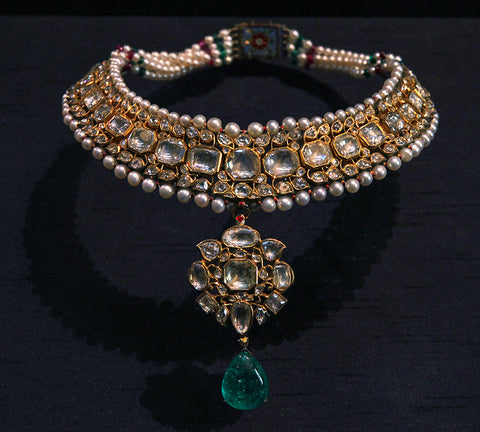
Mirror Cut
The mirror cut can sometimes go by the name of the Spread Table Cut, and is the direct result of diamonds that form in twin shapes known as macles. Macles are most commonly seen in octahedral diamonds and spinels, and are usually thick to the point where they can be made into brilliants with ease. Sometimes however, the flatness of a macle is taken in another direction, with their flat tops polished to a mirror like finish. This a shallow diamond cut, with bevel style pavilion cuts, resulting in a diamond finish that can offer reflections the same as a mirror. This is an antique cut, coming into being somewhere in the 1500s, and is rarely used in modern cuts.
Mughal Mirror Diamond Necklace
The Mughal Mirror Diamond Necklace is one of the most famous examples of mirror cut diamonds today. It is made up of 5 old mirror cut diamonds, each of which has a carved emerald drop. The stones are help in place using silk thread to string everything together.
The origins of this unique “necklace” can be dated somewhere between the mid 16th and early 18th century, when it would have been worn as an arm band, many believe by a Mughal emperor. The largest diamond in the necklace is estimated to weigh approximately 28 carats, and it is considered to be the largest Spread Table Cut or Mirror Cut diamond to survive into modern times. The five diamonds in the necklace weigh approximately 96 carats.
 A close up of the mirror cut diamonds from the necklace above.
A close up of the mirror cut diamonds from the necklace above.
 This necklace, currently housed in the British Museum, features a center row of spread table cut or mirror cut diamonds. This necklace also includes table cut, old mine cut and polki cut diamonds.
This necklace, currently housed in the British Museum, features a center row of spread table cut or mirror cut diamonds. This necklace also includes table cut, old mine cut and polki cut diamonds.